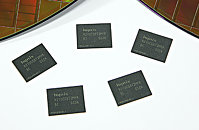Monday, August 9th 2010
Hynix Begins Mass Producing 20 nm Class Technology 64 Gb NAND Flash
Hynix Semiconductor Inc., today announced that it has begun mass producing 64 Gigabit (Gb) NAND Flash using 20nm class technology at its 300mm Fabrication, M11 in Cheongju site. The Company developed this cutting edge technology last February.
Hynix's 20nm class 64Gb chip doubles the density in a package over the current 32Gb product. 20nm class process technology also provides a 60% increase in productivity over Hynix's existing 30nm class technology. By providing these high density and cost efficient chips, Hynix will respond to the needs of advanced mobile solutions which require smaller size and higher density storage capacity.The Company said it has also developed NAND Flash solution products which combine Hynix's 30nm class 32Gb Flash chips and controller devices from Anobit, an Israeli NAND-based solution provider, through a strategic alliance between the two companies. This solution product operates at a high speed and significantly improves the reliability as a storage device. The newly mass-produced 20nm class NAND Flash chips will also be combined with the controller device and will be validated in September 2010.
"Hynix decided to mass produce the industry's highest density64Gb chips using 20nm class technology in order to fully satisfy demand from the customers. With these 20nm class 64Gb chips, the Company is enabled to provide customized, high performance products in a timely manner which perfectly suitsmobile solutions including smartphones, table PCs and others," said Dr. S.W. Park, Executive Vice President and Chief Technology Officer of Hynix.
Hynix's 20nm class 64Gb chip doubles the density in a package over the current 32Gb product. 20nm class process technology also provides a 60% increase in productivity over Hynix's existing 30nm class technology. By providing these high density and cost efficient chips, Hynix will respond to the needs of advanced mobile solutions which require smaller size and higher density storage capacity.The Company said it has also developed NAND Flash solution products which combine Hynix's 30nm class 32Gb Flash chips and controller devices from Anobit, an Israeli NAND-based solution provider, through a strategic alliance between the two companies. This solution product operates at a high speed and significantly improves the reliability as a storage device. The newly mass-produced 20nm class NAND Flash chips will also be combined with the controller device and will be validated in September 2010.
"Hynix decided to mass produce the industry's highest density64Gb chips using 20nm class technology in order to fully satisfy demand from the customers. With these 20nm class 64Gb chips, the Company is enabled to provide customized, high performance products in a timely manner which perfectly suitsmobile solutions including smartphones, table PCs and others," said Dr. S.W. Park, Executive Vice President and Chief Technology Officer of Hynix.


16 Comments on Hynix Begins Mass Producing 20 nm Class Technology 64 Gb NAND Flash
EDIT: Imagine squeezing more chips on a 3.5 SDD. Something to bridge the capacity expensive 2.5 and the UBER expensive pci-e based SSDs.
3TB (standard internal) drives arnt even out... HDD capacity has been dragging along soo slowly .....
they wont be bootable either, unless your board has an EFI instead of BIOS
I don't see why anyone would use a 3 Terabyte drive as a boot drive anyways (unless you only have that single hard disk).
i dont want a 3TB drive for my OS... i want a 6TB drive for my Raid Array... etleast 4 - 6 of them would do nicely.
you have to remember, (most of the time) with incressed density comes incressed speed.
It doesn't look like the hard drive makers are ready to quite any time soon though...
I would hope ram costs on the consumer end will go down soon. I wonder if this move by Hynix will make ram cost more or less.
About HDDs—HDD manufacturers may not see enough need for higher-capacity models to make their development a critical priority. What percentage of computer users out there would you guess have a need for even 2TB of total storage capacity per computer? Whatever percentage actually needs more than that probably consists mostly of power users who can run more than one HDD. So how much market is there really for >2TB HDDs? (Personal note: on average, my customers these days are looking for ~1TB of total usable HDD capacity.)
At any rate, I could see $1/GB being average for mainstream SSDs twelve to fifteen months from now.
That's the way I'd set things up, anyway.